|
Yo-yo help index
COPYRIGHT EURO-YO.COM and SkillToyz.com 2018
If you have any yoyo questions not answered here, email me and I will try to help.
Yo-yo Strings
How to wind on a yo-yo string
How to remove a string from a yo-yo
How to put a new string on a yo-yo
How to Double Loop a yo-yo string
How to put a yo-yo string on your finger
How often should I change my yo-yo string?
What causes a yoyo string tangle?
How long should my yo-yo string be?
Which yo-yo string can my yo-yo use?
How do the different yo-yo strings affect play?
Why do my strings keep breaking?
What are left-handed strings?
Yo-yo Basics
What is a traditional-shaped yo-yo?
What is a modified-shaped yo-yo?
What is a wing-shaped yo-yo?
What is a H-profile yo-yo?
How to tighten a yo-yo
How to hold a yo-yo
What is the yo-yo gap?
What is a 'sleeping' yo-yo?
What is a transaxle?
What is a ball bearing axle?
What is a hubstack?
What is a pog?
How to remove a yo-yo pog
What does 'stock' mean?
Yo-yo Maintenance
How to remove a ball bearing?
My yo-yo is noisy?
Should I oil my yo-yo?
How often should I oil my yo-yo?
Care of your Metal Yoyo
How to clean your Yo-Yo bearing
What is the difference between thick and thin lube?
How to stop your yo-yo side cap (pog) falling out.
Yo-yo Response Systems
What is a response system?
What is a Starburst response system?
What is an O-ring response system?
What is a Hybrid response system?
What is a Brake Pad response system?
What is a Friction Sticker or Pad response system?
What is a recessed response system?
What is a siliconed response system?
Yo-yo Play
Why won't my yo-yo come back up?
How can I make my yo-yo sleep longer?
What is 'binding' and how do you bind a yoyo?
Why does my yo-yo hang to one side when I throw it?
Has my yo-yo got vibe or wobble?
Why does my Auto-return yo-yo not return anymore?
Do I need a yo-yo glove?
How do you learn to yo-yo?
Choosing a Yo-yo
What is the best yo-yo?
What yo-yo sleeps the longest? |
|
| |
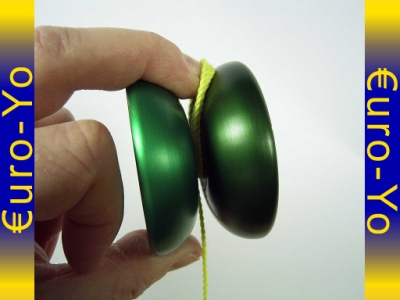
How to wind on a yo-yo string
How to wind a string on a yo-yo.
The photo shows how to use a finger to help you start winding on a yoyo string.
I do actually get asked this! Unless you have been told or shown, the trick is not immediately obvious.
When winding a string on a yoyo you might find the string moves around the yoyo axle without winding on. The simple solution is to put a finger under the string and wind the string over your finger a few times. You can then remove your finger and continue winding the string.
This happens because most modern yo-yos have a transaxle or ball-bearing axle system that allows the yoyo to spin freely on the end of the string (ie 'sleep'). When you try to wind the string on the yoyo, the string will just turn on the axle indefinitely. Use your finger to trap the string until sufficient string is bunched around the axle for you to remove your finger and wind the string on.
Return to top
|
|
| |
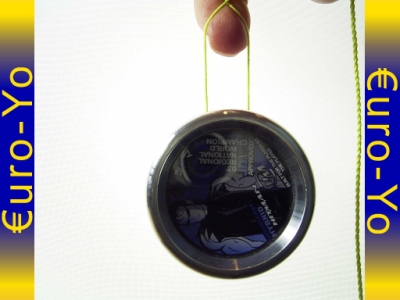
How to remove a yo-yo string
How to remove a string from a yo-yo.
Photo: shows how you can unwind the yo-yo string to make a loop, which then allows you to remove the yoyo string without undoing the yo-yo halves.
There should not be any need to undo a yoyo to remove the yoyo string. In fact, it is better to avoid undoing a yoyo unnecessarily. However, if the string is tangled, then you might have to undo the two halves of the yo-yo to remove the string. Remember, not all yo-yos have a 'take-apart' design.
To remove a yoyo string without undoing a yoyo:
1. With the yoyo hanging from one hand, unwind (untwist) the yoyo string to form a large loop.
2. Pull the loop over and off the yoyo.
You are now ready to replace the yoyo string.
Return to top
|
|
| |
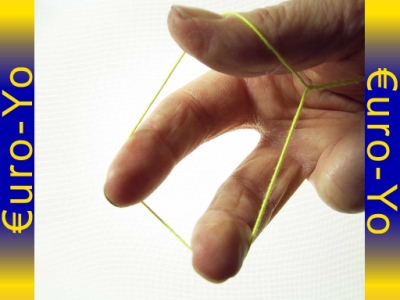
How to replace a yo-yo string
How to put a new string on a yo-yo.
The photo shows how you can make the loop at the end of the yoyo string big enough to go over the yo-yo and onto the bearing without having to undo the yo-yo halves.
There should not be any need to undo a yoyo to fit a new yoyo string. Just follow these steps!
1. Remove the old yo-yo string (see 'How to remove a yo-yo string').
2. Find the loop end of a new yo-yo string. Make the loop bigger until it is big enough to slip over the yo-yo.
3. Re-twist the yo-yo string by letting the yo-yo hang from the yoyo string and tightening (winding) the yo-yo in a clock-wise direction. The loop will then close onto the axle.
All done!
Return to top |
|
| |

How to Double Loop a yo-yo string
Usually when you put a yoyo string on a yoyo, you loop the yoyo string around the axle just once. To make the yoyo return to the hand more readily, you can double or treble loop the string around the axle. To do this, after you put the string on the axle, twist the yoyo string and then repeat the procedure to put it over the axle again and so form a double loop. For an even more responsive yoyo you can repeat this 3 or four times. Easy to do, but hard for me to describe!
Double or treble looping is also commonly used on transaxle yoyos like the Fireball and yoyos with wooden axles like those made by Tom Kuhn.
Return to top |
|
| |
|
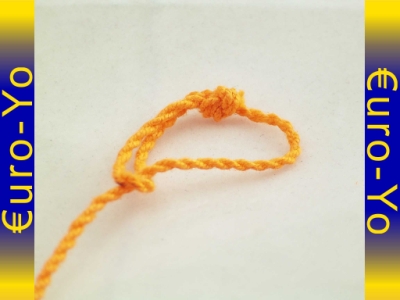
How to put a yo-yo string on your finger
The picture shows the yoyo string with the slip-knot ready for use.
One end of the yo-yo string has a knotted loop. This loop does NOT go on your finger. You use this loop to create a slip-knot and this goes on your finger. To make the slip-knot, simply pass the string through the knotted loop as shown. This slip-knot will tighten to fit snugly around your finger.
Remember: the yo-yo string goes around the player's middle (longest) finger, between the two knuckles of the finger.
Return to top
|
|
| |

How often should I change my yo-yo string?
As your yoyo string wears out it will become weaker, dirty (sweaty hands, lube, that donut you ate etc!) thinner, frayed and less 'fluffy'. This changes the way the string plays and will make the string more prone to breaking. Annodised metal yo-yos can have a slightly rough coating resulting from the annodising and laser engraving processes that can wear out yo-yo strings more rapidly at first.
Some players change their strings after every few hours of play. As a rule I would change the string as soon as it appears to be frayed or 'tired'. If a yoyo string breaks during play your yoyo can be propelled across the room, damaging itself and anything in it's path. So apart from a new string playing and looking nicer than a tired old one, it could save you money, injuries and yo-yos!
Return to top |
|
| |

How long should my yo-yo string be?
As a guide, a yoyo string should extend from the floor to your belly-button. When you fit a new yoyo string to your yoyo, you will need to check it's length since the length of yoyo strings will vary. Put the new string on your yoyo and let it hang so it just touches the floor. Where the string is level with your belly-button, you want to knot in a loop. Then cut the excess string from the yoyo. Yes, this does mean you will often end up cutting off the existing pre-tied loop on your yoyo strings!
Return to top |
|
| |
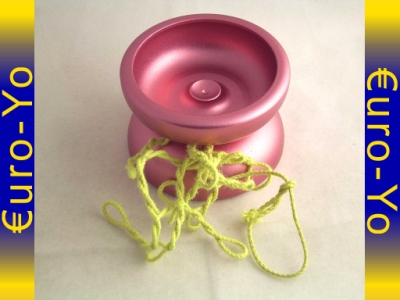
What causes a yo-yo string tangle?
The picture shows over-twisted yoyo string.
If you find your yoyo string ends up looking like this, then it is due to it becoming over-twisted (tightened). During play the yoyo string has become more and more wound up, and when the string is at rest it twists itself into a fine mess.
To undo this twisted tangle, simply let the yoyo hang freely from your finger. The yoyo will rotate, and the string will untwist until it is in a 'neutral' state. In its 'neutral' state, the yoyo will not rotate any more. To speed up this process you can pinch the string at the top of the yo-yo and then draw your pinched finger down the string. You will see the yoyo rotate more quickly as a result. You may need to do this several times.
There is also a neat trick called a sidewinder that can be used to untighten (or tighten) a string.
Return to top |
|
| |

Which yo-yo string can my yo-yo use?
Any yo-yo string can be used with any yo-yo. They are all broadly the same and perform the same function. You do not need to use (for example) Duncan Strings with a Duncan yo-yo. You can use any make of yo-yo strings with any make of yo-yo.
However, some strings suit some yo-yos better than others. For example, looping yo-yos are generally better used with a thicker cotton strings, because of the way the string affects the play of the yoyo.
Return to top |
|
| |
|

How do the different yo-yo strings affect play?
Cotton strings tend to be the softest and the thickest of the strings. They have a less slippery surface and so are a little more responsive in play. Some players prefer these for looping yo-yos.
Cotton polyester mix strings are commonly called 'slicks'. So for example, 'slick 6's' are a 50/50 cotton/poly mix type 6 yoyo string. As the name suggests, these are a bit more slippery and less responsive in play. They are also quite hard-wearing. They are very popular, and favoured by many players for use in 'V' or 'Wing' yoyos when used for string tricks where less response is needed.
100% Polyester strings are increasingly popular and are made purely from polyester. These synthetic strings are the least responsive of the strings. That is to say, they offer the least friction between string and yoyo. This promotes longer spin times especially when used in multi-layered string tricks where a lot of string comes into contact with the spinning yoyo.
There are new synthetic strings coming out which offer other characteristics for the more advanced and specialist players.
Type 6 / Type 8 / Type 9 - this refers to the way in which the yoyo string has been made and how many yarns or threads are within the string. As a rule, the lower the number the thinner and less responsive the string.
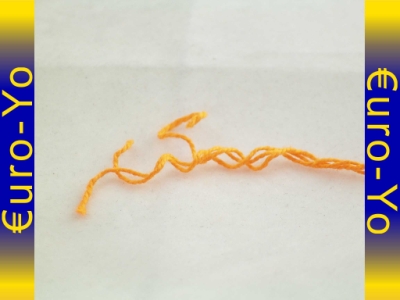
Return to top
|
|
| |

Why do my strings keep breaking?
All yoyo strings will wear out and eventually they will break. Some strings will last longer than others. It is important to change your yoyo strings quite regularly, and as soon as there are any signs of fraying or worn string. Remember: a new string costs a few pence, but your new yo-yo flying into the room if a string breaks could be a lot more costly.
Some things will cause strings to wear out more quickly:
If you are playing with a new metal yoyo, then the anodised or other coating on the surface of the yo-yo can be like very fine abrasive paper. Yo-yo strings will quite quickly wear out. After a time this abrasiveness will wear off.
If your yoyo has any damage ('dinks') these might be wearing your string out.
Some plastic yoyos are not perfectly finished: check them for any irregularities.
Cotton and poly/cotton yoyo strings can deteriorate over time. Keep them dry.
Return to top |
|
| |

What are left-handed strings?
Left-handed yo-yo strings have the twist in the string in the opposite direction to normal yo-yo strings. The twist of the left-handed strings is in an anti-clockwise direction. The twist in right-handed yoyo string is in a clockwise direction.
Return to top |
|
| |

What is a traditional-shaped yo-yo?
The photo shows a Duncan Imperial Yo-yo which has a traditional shape
The 'traditional' shaped yo-yo is also commonly called the 'Imperial'™ shape. However, the name 'Imperial'™ is a registered Trade Mark of Duncan Yo-yos and so, despite the term 'Imperial'™ being in very common use, Duncan have asked us not to use that name to describe a traditionally shaped yo-yo. Duncan have asked us to refer substitute the term "Straight Gap". I have never heard anyone refer to the traditional shaped yoyo as a straight-gap and I don't intend to start doing so here! ;-)
Return to top
|
|
| |

What is a modified-shaped yo-yo?
The photo shows the modified shape of a Tom Kuhn SB2 yo-yo
The modified (often referred to as the modified Imperial™) shaped yoyo is somewhere between a traditional shape and a wing-shape. Most modern looping yo-yo's favour the modified shape rather than the traditional shape.
Return to top
|
|
| |
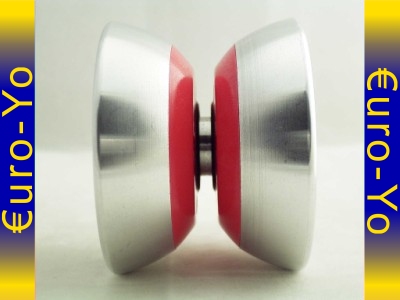
What is a wing-shaped yo-yo?
The photo shows the wing profile of a YoyoJam xconvict yoyo.
The Wing-shape is commonly known as the Butterfly™ profile, but like the Imperial™ profile this is a trademark of Duncan Yo-yos and we have been asked by their legal people not to use it. Even though it is, in my opinion, in common use. They own the trademark to that word and you are not to use it. And nor will we. ;-)
The wing shape is also known as the V or Vee shape, flared wing, Lepidoptera etc
This shape provides a large gap on which to catch the yo-yo on the string when performing string tricks. It is the modern yoyo shape and the shape most yo-yos are when playing 'new-school' yo-yo tricks.
The shape is not so suited to looping tricks since the V shape means a wider yoyo which means less axial stability.
Return to top |
|
| |
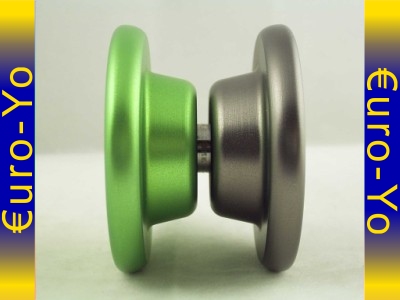
What is a H-profile yo-yo?
The photo shows the H-profile of the hspin Envy 64 yo-yo.
This is a very new yoyo shape, presently featured in some hspin and YoyoFactory yo-yos.
Return to top |
|
| |

How to tighten a yo-yo
The photo shows how you can use the palms of your hands to gently tighten a yoyo.
One of the weakest parts of a yo-yo is where the axle joins the yo-yo body. If you overtighten a yo-yo you can shear (tear) the thread from the axle or from the threaded hole in the yoyo body. Trust me, this is a very common cause of broken yo-yos. To help avoid this, you can tighten a yo-yo using the palms of your hands as shown in the photo.
Return to top |
|
| |

How to hold a yo-yo
The photo shows the most common way to grip a yo-yo during play.
The slip-knot end of the yo-yo string is around the player's middle (longest) finger, between the two knuckles of the finger. The string passes from the underside of the yoyo to the finger as shown. This provides the correct spin when the yoyo leaves the hand.
Return to top |
|
What is the yo-yo gap?
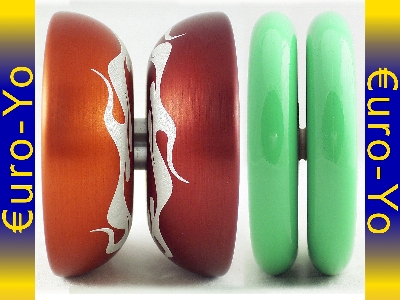
The photo shows a hspin Pyro yoyo (left) which has a large gap next to the Duncan Proyo yoyo (right) which has a narrow gap.
The yo-yo gap is simply the gap between the yoyo halves. Large gaps make for a less responsive yoyo which is better suited to string tricks and off-string play. It is easier to catch a yoyo on the string if the gap is larger. Small gaps are more responsive and best for looping tricks.
Return to top
|
|
What is a 'sleeping' yo-yo?
A sleeping yo-yo is simply one that is spinning. To throw a 'sleeper' means you throw the yo-yo so that it does not return to the hand, but instead 'sleeps' or spins on the end of the yoyo string. To make the yo-yo return, you give the yoyo string a tug or perform a bind.
Some yo-yo enthusiasts compete to see who can make their yo-yo sleep longest. The key to success includes a very good hard throw, a good yoyo, a high quality clean bearing, and a lot of skill.
Return to top
|
|
What is a transaxle?
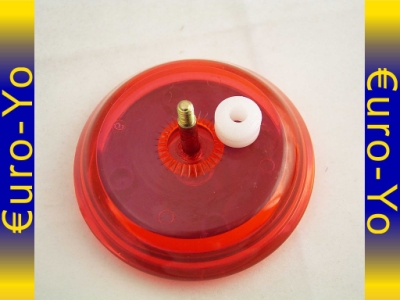
The photo shows the simple but effective transaxle assembly of a Yomega Fireball yoyo.
'Transaxle' describes a collar or sleeve that fits over and rotates around the yo-yo axle. This reduces friction between the yoyo and the string and helps the yo-yo to sleep. Lubrication can further reduce friction. An early improvement on the fixed axle yoyo, the transaxle does provide markedly better sleep times than fixed axle yo-yos but cannot compare to a ball-bearing axle.
Return to top
|
|
What is a ball bearing axle?
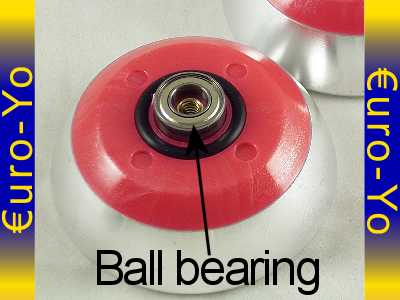
A ball bearing axle refers to the use of a ball bearing around the yoyo axle to hugely minimise friction when a yoyo is spinning. The ball bearing is similar to that found on a Tamiya model racing car, skate board, roller skate etc. Ball bearing axles provide the lowest friction and so the greatest sleep times on a yo-yo.
Return to top
|
|
What is a hubstack?
Hubstacks were developed (and I think patented) by Yoyofactory. Variations on the design are appearing from other yoyo makers. A hub stack is a cap on the side of the yoyo that rotates on a bearing on the same axis as the yoyo axle, so you can hold the yoyo by the hubstacks and do new tricks. A yoyo with hubstacks has a total of 3 ball bearings, the main bearing plus two smaller hub bearings.
There are disadvantages of these additions: they are costly, put more weight towards the centre of the yoyo rather than on the rims, can make a yoyo unbalanced and can introduce wobble. But they do offer up scope for developing innovative new tricks. There are a variety of different tips that can be put on the hub stacks, including long tips, top tips (that turn your yoyo into a kind of spin top) and T stacks that offer a larger area to catch and hold the spinning yoyo.
Return to top
|
|
What is a pog?
A pog is a round side cap or hub on a yo-yo. They are fitted in pairs. Pogs are more commonly fitted to plastic yo-yos. They are generally for cosmetic purposes and removing them will not usually affect play much (though it will lighten the yo-yo a little). Pogs are often printed with artwork. Pogs on many of the YoYoJam yo-yos are circular clear plastic inserts with a paper insert underneath them printed with artwork. On many yo-yos, especially those by YoYoJam, it is possible to remove the pogs and replace the artwork with your own designs.
Return to top
|
|
How to remove a yo-yo pog
Usually the pogs (side caps) on yo-yos can be removed. If you wish to do this, please do so with care to yourself and your yo-yo. If you use any of the methods described, you do so at your own risk. Children, please ask for an adult to help you!
The fitting and so the method of removal varies with manufacturer. Suction cups are often recommended to pull the pogs off a yo-yo. It can be hard to get a suction cap that is strong enough to do the job. A small screwdriver can prise off some pogs if inserted at the edge of the pog.
On some yo-yos such as some Duncan yo-yo models, the pogs have a small groove or recess on the edge of the pog into which you can carefully insert a very small flat-headed screwdriver and lever off the pog.
YoYoJam pogs are clear round plastic discs which are tightly pushed into the side of the yo-yo. They can be challenging to remove! Sometimes a suction cup will work. Otherwise, you can try pushing the pog hard on one side so that the pog rocks over the central raised area in the middle of the yo-yo, causing the pog to pop out at the other end (easier done than described!). Another method I have tried is to warm the pog with some steam to make it more pliable. Be warned this can spoil a pog.
With the Yoyojam yoyos, once you have managed to remove the clear plastic pog cover it is easy to replace the paper pog with the logo on it with whatever alternative you like. If you want to create your own pog you can use the plastic pog as a template for the new paper pog size. Draw, print, paint, use metallic paper - it can make an otherwise common yoyo look pretty unique!
Other pogs I have come across have one small hole in them. You can insert a screwdriver or use a hook such as a bent paper clip or allen key and pull the cap off.
Some pogs are not easily removed and may even be glued in place. It is possible to crack some pogs, be careful.
Return to top
|
|
What does 'stock' mean?
The term 'stock' used in a yo-yo description usually means it is fitted as standard. So if you read something like "silicone pads fitted as stock" it means the yo-yo is supplied fitted with silicon pads as standard by the maker. You might also hear something like "the yo-yo is unresponsive as stock" which means the yo-yo is unresponsive as new without you having to make any changes to it.
Return to top
|
|
How to remove a ball bearing?
The actual fitting of a ball bearing varies but generally the bearing is simply pushed into a recess in the yoyo on a bearing 'seat'. On some yo-yos the ball bearing is a very tight fit and is not easy to remove.
It is not always necessary to remove a ball bearing from a yoyo but if you need to and the bearing is too tightly fitted to be removed using just your fingers, here is a tip: wrap a wide rubber band around the yoyo bearing. This will protect the bearing. Then use pliers over the rubber band and use GENTLE pressure to rotate and rock the bearing and pop it out of the recess. If this does not work you can try NOT using the rubber band but be very careful!
Note: remove a bearing at your own risk! It is very easy to damage a yoyo bearing by exerting too much pressure during removal. Do not apply too much pressure on the bearing when using pliers in this way. Too much pressure can break a bearing, or squash the bearing and make it fit even more tightly on its seat. Light pressure coupled with a backward and forward rocking of the bearing in the recess should do the trick. Do NOT use pliers without a protective rubber band over the bearing since the pliers will scratch and ruin the bearing. Take care not to scratch the yo-yo itself.
There is an excellent video guide to this by YoyoFactory posted on YouTube. Here is the URL:
http://www.youtube.com/watch?v=ZS_K-98jX0w
Return to top
|
|
My yo-yo is noisy
It is normal for yo-yo's fitted with a ball bearing axle system to be surprisingly noisy. You can hear the bearing rattle when you shake the yoyo, or the bearing will be noisy when you throw (play) the yoyo. What you can hear is the tiny ball bearings moving within the bearing cage. Some yoyos are surprisingly noisy when spinning. The degree of noise varies according to the particular bearing, yoyo and the lube within the bearing.
Excessive noise might indicate the bearing needs a tiny drop of lube - the bearing could be running a bit 'dry'. Be warned that adding a tiny drop of YoyoJam thin lube can make the yoyo less responsive (a good or bad thing, depending on how good a player you are). Any thin oil (sewing machine oil for example) would also do.
The amount of bearing noise does vary, even on the same yoyos with the same bearings, which I would put down to the different amounts and consistency of lube in the bearing. It is not normally an indication of a problem.
Return to top
|
|
Should I oil my yo-yo?
Note: Yo-yo oil is also known as 'Lube'
If your yoyo has a ball-bearing or transaxle fitted, then yes, a tiny drop of oil (lube) will be beneficial.
If your yo-yo has a fixed (usually wooden) axle, then no, do not oil it.
Oiling or lubricating a yoyo bearing will help keep the bearing in top condition by reducing friction and protecting it from moisture. Ball bearings are usually supplied to the yo-yo manufacturer's ready oiled, to protect them from moisture. The type of oil used will vary from a thin oil to a very thick grease. A thick grease will be very responsive and make the bearing spin less freely. For this reason, it is quite common practice to clean a yo-yo bearing to remove the grease applied during manufacture and replace it with something a little better. Conversely, a yoyo bearing that is not oiled ought to have a little light lube applied.
Note: a bearing that is not oiled at all is called a 'dry' bearing. It is not generally recommended to run any bearing totally 'dry' since it will tend to wear out more quickly.
Some bearing types such as ceramic bearings are shipped 'dry' and should be lubed before play.
Introducing a little light lube into a new ball bearing can help flush out any dirt from the bearing and thin any existing lube in the bearing. This is an alternative to cleaning a bearing (though not so effective).
If you do not have any yo-yo lube such as that by YoyoJam, Yomega etc, then sewing machine oil or a similar very light oil can be used. I have heard that Baby Oil can be used as a lube! I do not know if this would be any good, so I do not recommend it.
Do not contaminate the response system of any yo-yo with any lube or oil. Doing so can result in loss of response, swelling or loosening of pads or loss of adhesion of pads.
Return to top
|
|
How often should I oil my yo-yo?
Note: Yo-yo oil is also known as 'Lube'
Briefly: every couple of weeks.
How often you lube your yoyo depends on how much you play the yoyo, how much you like lube, which lube you use, if you are cleaning the bearing etc. As a guide I would lube it every couple of weeks and you only need the tiniest drop placed on the side of the bearing so a tube of lube will last a very long time. Also, if you do not have proper yoyo lube, then you can substitute a very thin light oil like sewing machine oil.
I would recommend a thin lube like the yoyojam thin oil. The Yomega brain lube is a medium lube. The Duncan lube is pretty thick stuff.
Most yoyos are supplied with their bearings ready lubed (oiled or greased) so a new yoyo should not need oiling for a few weeks. Just playing the yoyo will free up the bearing - it is called running it in.
If your yoyo seems slower (sleeps less so maybe dirty) or noisier (maybe running dry) then it is probably time for a tiny drop of lube.
Return to top
|
|
Care of your metal yoyo
Care of your Metal Yoyo
Metal yo-yos are NOT toys! They are expensive, precision-made, delicately engineered works of art. They are easy to damage or break and need to be treated with a lot of respect to ensure their long life and your yo-yoing pleasure.
Most metal yo-yos are made from aluminium which is a relatively soft metal. It will quite easily break, bent, rip and dent. One of the weak points of an aluminium yoyo is the joins between the axle and the yoyo halves. The threaded axle (which is usually made of a very hard steel) screws into a threaded hole in the relatively soft side of the yoyo. These threaded holes are easily damaged by mis-threading or over-tightening.
Mis-threading a yoyo axle will shred the thread in the yoyo halves. Mis-threading is caused by accidentally stripping the thread from the hole when screwing the axle in (when joining the 2 yoyo halves back together). This damage is permanent. When putting a yoyo back together, be very careful and take your time. If it feels tight, or looks bent or wonky, take it out and start again. Remember: the thread in the soft yoyo will strip off first, not the thread on the hard axle.
Over-tightening a yoyo can pull the thread through the soft metal of the yoyo, literally stripping the thread from the hole. You will be left with no thread to grip the thread of the axle, and a yoyo that falls apart. This will not be covered by an warranty!
If a metal yoyo is trodden or sat on, you will end up with a wonky yoyo with a wobble to match. Crushing a yoyo can cause the axle to bend, the threaded axle hole in the yoyo to distort, or the actual yoyo halves to become misshapen. All are bad news for any yoyo! Surprisingly, a common cause of squashed yoyos is when they are carried in a back pocket. The owner then sits down, the yoyo is crushed, the owner notices. Too late! One dead yoyo. A similar thing happens when someone puts their yoyo on the sofa then along someone sits on it. Buy a suitable case or holder for a yoyo for when you are carrying it or storing it!
Finally, dings. A ding is when your yoyo hits something hard during play and dents or scratches. It might hit the floor, a wall, the ceiling! Metal yoyos are amazingly easy to ding. Hitting something during play is almost inevitable. Dings spoil the appearance and performance of a yoyo. Until you are a really good player or have money to burn, I would recommend playing in a large room away from walls or furniture and over a soft (e.g. carpeted) floor. Concrete floors, brick walls and pavements are a definite no-no!
So the golden rules are:
1. Never over-tighten a yoyo.
2. Never mis-thread a yoyo.
3. Do not carry a yoyo in your pocket
4. Do not sit or tread on a yoyo
5. Play over a soft surface
6. Put your yoyo somewhere safe when not in use!
7. Treat your metal yoyo with respect
Finally a plea to parents: PLEASE do not buy your child an expensive metal yoyo. These really are not kids toys. It is not at all uncommon for a child to be bought one of these and for it to last one week before it is broken.
Return to top
|
|
How to clean your Yo-Yo bearing
IMPORTANT: Please see "How to remove a ball bearing" if your bearing is difficult to remove.
Yo-yo bearings will get dirty and will eventually need cleaning to maintain performance. Tiny bits of dirt, fluff from the yoyo string, fragments from the response pads etc will sometimes find their way into the bearing. If your bearing slows down or becomes noisy the first thing to try is cleaning the bearing.
The metal ball bearings fitted to many yo-yos are generally supplied pre-oiled or 'lubed'. That is to say they leave the factory with a load of oil or even thick grease in the bearing to preserve it from moisture and keep it in top condition. The down side of this is that many oils and greases are too thick and will make your yo-yo bearing slower and will cause it to spin for less time. Your yo-yo will sleep for less time. This might be a good thing on a yo-yo that is to be used for looping tricks, but for string tricks you really want a yo-yo that spins freely for the longest time possible.
The most thorough solution is to clean your new yo-yo bearing then lightly oil or 'lube' the bearing with a very light (thin) oil such as sewing machine oil, or better still a yo-yo lube designed for the job. The YoyoJam Thin Lube is highly recommended.
*** Children, please ask an adult for help doing this *** To clean a yo-yo bearing remove the bearing from the yo-yo (see separate help section). Place the bearing in a small glass container with a lid. Cover the bearing in a generous amount of White Spirits (also known as mineral spirits) and replace the lid. Give the container a vigorous shake for about a minute to thoroughly clean the bearing. Remove the bearing and dry on paper towel. Safely dispose of the used White Spirits. Pad the bearing dry with the paper towel and then allow the bearing to air dry for another 15 minutes or so. Now lightly lube the bearing with a tiny drop of lube placed on the side of the bearing. Replace the bearing in the yo-yo and you should see a BIG difference!
Some players like to use compressed air to blow any dirt out of a de-shielded bearing after cleaning. Another technique is to lightly lube a de-shielded bearing then use compressed air to blow the lube and any dirt out of the bearing.
Note: Contrary to popular belief, there is usually no need to remove the dust shields from the side of a bearing prior to cleaning unless there are really large particles of dirt inside the bearing. I would only remove the clip if the bearing has something stuck in it. Normally just a rinse is sufficient. If you clean the bearing with the clip on and it is still responsive, then it is worth removing the clip. Removing the clip allows any larger particles to be flushed or blown out of the bearing.
Some players like to clean a bearing periodically to maintain optimum performance and remove any build-up of dirt in the bearing. A common source of dirt in a yo-yo bearing is particles of the response system that have worn from the pads or o-rings during play. This build-up of muck in the bearing can reduce the performance of your yo-yo over time and is easily fixed with a good clean.
Note: do not run a yo-yo bearing dry (ie. without any oil or lube) - it is not good for it in the long term.
A note about ceramic yo-yo bearings: These can be cleaned in the same way. Do not forget to add a drop of thin lube. Do not run dry.
I do not recommend using lighter fluid to clean a yo-yo bearing because I have read that it is too volatile and can leave deposits on the yo-yo bearing. I prefer to use White Spirits (mineral oil). It gives excellent results!
Note: White Spirit is called Mineral oil in the USA.
Return to top
|
|
What is the difference between thick and thin lube?
Note: Yo-yo 'lube' (lubricant) is another name for yoyo oil.
Yoyo lube comes in different thicknesses. This is the thickness or viscosity of the oil.
A thick lube will be slow down a yoyo bearing more than thinner oil, making the yoyo more responsive. This might be desired if your yoyo is too unresponsive and you want to make it more responsive (so that it returns to the hand more readily) or if you are using a looping yoyo where a more responsive bearing is often desirable.
A thinner lube will make the bearing run more freely with less resistance, making the yoyo less responsive. The yoyo will spin for longer and sleep times will be greater. This is usually desired for string tricks where you want the maximum spin time to perform a series of tricks.
YoyoJam have called their lube 'thick' and 'thin'. The YoyoJam thin oil is the thinnest of the oils. The Duncan lube is thick. The yoyojam Brain Oil is somewhere in between thick and thin.
If you do not have any yo-yo lube then sewing machine oil or a similar very light oil can be used.
Return to top
|
|
How to stop your yo-yo side cap (pog) falling out.
If the yo-yo pog is not fitted correctly or is a little loose it can sometimes fall out. In many yo-yos (such as theYoyoJam range) the pogs are circular embossed plastic cutouts which simply push into place, so they can be removed if required. If they are not pushed in properly they can fall out. If your pog falls out, it should just push firmly back into place, ensuring it is inserted evenly and fully. It should be quite a snug fit. But if the pog is still a little too loose, you can carefully pinch the very edge of the pog in a few places on the outer edge with some pliers to squash the plastic pog and make it have small protruding edges. It is hard to describe, but you are effectively making the pog a little bigger in diameter by crimping the edge of the pog. This should result in a well fitting pog. This method works very well with the YoyoJam yoyos, but please do this at your own risk!
Return to top
|
|
| |

All about yoyo strings
The photo shows the construction of a type 6 yo-yo string.
There is a bewildering variety of yo-yo strings. Different types, colours, materials and lengths. I often get asked 'what is the difference', and 'which yoyo string should I use'. Here are some answers!
How is a yo-yo string made?
Yo-yo strings are quite clever. They are made of a single length of string which is doubled up and then twisted (wound up) to make a single string with a loop at one end. The two ends are usually knotted. The end with the loop is where the yoyo axle goes; the loop wraps around the axle.
How long are yo-yo strings?
There is no standard length. Yoyo string lengths vary with manufacturer and even with the batch produced.
Return to top |
|
What is a response system?
When a yo-yo is thrown, it is the yo-yo response system which makes it return to the hand. The response system is all the parts that make the yo-yo responsive. Basically a yo-yo response system creates friction between the yoyo and the yoyo string which makes the yoyo climb back up the string. The main types of yo-yo response systems are described below.
Terminology: a responsive yoyo is one that returns to the hand easily. An unresponsive yo-yo is one that sleeps (spins at the end of the yoyo string) and does not return to the hand easily.
Return to top
|
|
What is a Starburst response system?
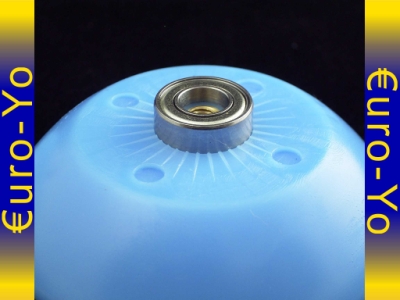
The photo shows the starburst in a YoyoJam Speedmaker yoyo.
What is a Starburst response system, what does it do, how does it work, what modifications are possible?
A 'starburst' response system is a common response system used in yo-yos. Response systems cause the yoyo to return to the hand. A starburst is the name given to a series of raised ridges arranged around the centre of a yo-yo, around the bearing, as shown in the photo (the photo shows a YoyoJam Speedmaker). The ridges cause friction between the string and the yoyo. When the yoyo is sleeping, this friction will be low, but if you tug the yoyo the string will tend to bundle against the sides of the yoyo and the friction from the starburst pattern will be enough to cause the yoyo string to wind back around the yoyo and so returns the yoyo to the hand.
Some new yo-yos, notably the YoyoFactory SpeedDial use an adjustable starburst system.
Pros: A simple, cheap and effective response system. Never wears out.
Cons: It can be a little harsh, making the yo-yo 'bite' or 'snap' back at you. It is not easily modified.
Modifications: You can reduce the amount of friction a starburst produces by removing or reducing the height of some of the ridges (with a knife or fine grit paper) but this is not recommended unless you know what you are doing. You can also use washers or 'shims' to widen the gap and reduce the responsiveness.
Return to top
|
|
What is an O-ring response system?
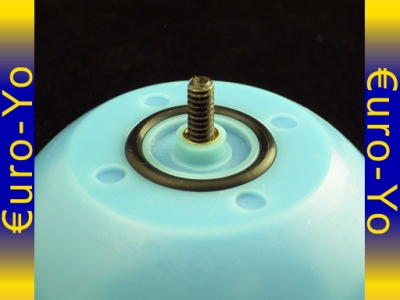
The photo shows the O-ring in a YoyoJam Speedmaker yoyo.
What is an o-ring response system, what does it do, how does it work, what modifications are possible?
O-ring aka Yo-Ring (YoyoJam)
An o-ring is simply a ring of a rubber-like material. The o-ring in fitted into a circular groove in the inside of the yoyo, around the bearing. It stands slightly proud of the surface of the inner face of the yoyo. The 'o-ring' is used in a yoyo to provide friction (response) between the yoyo and the yoyo string. Like a starburst, this friction causes the yoyo to return to the hand.
The photo shows an o-ring in a YoyoJam Speedmaker yo-yo: it is the black rubber ring inserted into a recess on the inside of the yoyo.
Pros: A simple, cheap and effective response system. In my opinion this is a bit more subtle than a starburst. Extremely slow to wear out. Easy to replace. Can be modified.
Cons: Perhaps not as many options as a friction sticker or pad. Like the starburst, it is not that easily modified.
Modifications: Different types of o-rings (such as silicon o-rings) with differing levels of responsiveness are available. By changing the o-ring you can modify the response of your yoyo. You can also use washers or 'shims' to widen the gap and reduce the responsiveness.
A quick and simple mod is to remove just one o ring.
More radical changes to response can be achieved using a sharp knife to trim back the o ring Not recommended unless you know what you are doing; you could easily ruin your yoyo. Kids - PLEASE don't mess around with knives! Trimming the o-ring back until it is flush with the surface of the yoyo will greatly reduce the response of the yoyo. It will sleep longer but it will be much harder to get to return from a sleeper, you may even need to use a bind.
You can also remove the o-ring and fill the groove that the ring fits into with flowable silicon. This will make a very smooth unresponsive yo-yo.
Return to top
|
|
What is a Hybrid response system?
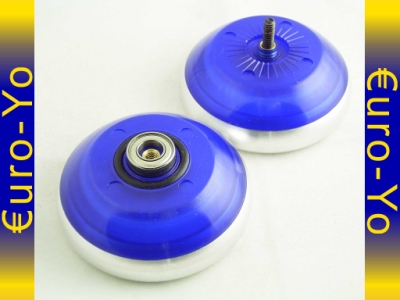
The photo shows the hybrid response in the YoyoJam Hybrid Hitman yoyo.
What is a Hybrid response system, what does it do, how does it work, what modifications are possible?
A hybrid response is simply the use of two different response mechanisms in the same yoyo. Usually this means the use of the starburst response in one half of the yoyo, and the O-ring in the other half. This hybrid mix of response systems provides a different feel that is popular with many players. Presently YoyoJam is the main yoyo manufacturer using this technique and I believe they originated the idea. The photo shows the hybrid response in the Hitman Hybrid with one half of the yoyo having the starburst and the other the o-ring.
Pros: A simple, cheap and effective response system. Unique feel. In my opinion this is a more subtle than a pure starburst. The starburst will never wear out, and the o-ring is extremely slow to wear out. You can replace the o-ring. Can be modified.
Cons: Some players prefer the pure o-ring response but this is all down to personal preference.
Modifications: You could attempt the modifications given above for either the o-ring or the starburst or both! The pure o-ring response is more easily modified. You can also use washers or 'shims' to widen the gap and reduce the responsiveness.
Return to top
|
|
What is a Brake Pad response system?
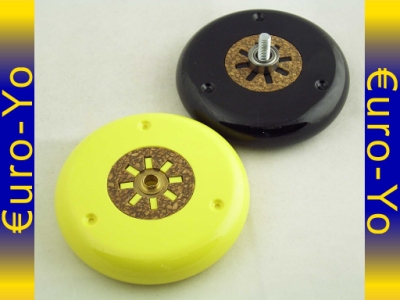
The photo shows a brake pad fitted in a Duncan bumblebee yoyo. .
What is a Brake Pad response system?, what does it do, how does it work, what modifications are possible?
A.K.A. Duncan Brake Pad
Brake pads are made by Duncan and fit some of the Duncan range of yo-yos. A Duncan brake pad is a shaped and cut piece of thin cork-based material with an adhesive backing. Rather like a friction sticker made of cork.
The brake pad causes friction (response) between the yoyo and the yoyo string, helping the yoyo return to the hand.
Pros: Simple, cheap and effective response system. Long-lasting. Easy to replace.
Cons: Not widely used now. Only fits Duncan yo-yos that are designed to use it.
Modifications: Very limited scope for mods. You can reduce the response by sanding the brake pad (not recommended unless you know what you are doing!).
Return to top
|
|
What is a Friction Sticker or Pad response system?
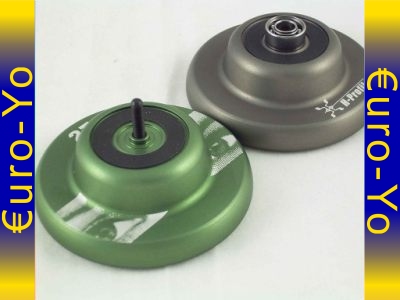
The photo shows the recessed pads fitted to the hspin Envy64 yoyo.
What is a friction sticker or pad, what does it do, how does it work, what modifications are possible?
A friction sticker, also known as a pad, is a flat ring of material that is stuck to the inside of a yoyo around the bearing. They are made from many different materials, and new materials are always being tried. Common materials currently include different types of rubber, vinyl, plastic, cloth, silicon, and synthetic rubber-like materials. They are usually supplied with a peel-off backing covering a self-adhesive coating which sticks the pad to the yoyo.
As with the other response systems, the pads provide friction between the string and the side of the yoyo to make the yoyo return to the hand. The different materials in use give different degrees of friction and hence affect the responsiveness of the yoyo.
Friction stickers come in a variety of sizes, and the size of the sticker refers to the size of the bearing they are designed to fit around. They also vary in thickness. Dif-e-yo make the best-known pads and they make them in two thicknesses: thin (0.015 inches) and thick (0.03 inches). Most pads are thin.
Pads can be mounted directly on the surface of the yoyo, but more commonly they are mounted in a depression or recess in the surface. This is where the term 'recessed response system' comes from - the pads are 'recessed' into the yoyo. This recess keeps the gap wide and further reduces responsiveness.
Pros: Arguably the most versatile response system, since it is pretty easy to replace pads to vary the way a yoyo plays.
Replacement pads are comparatively cheap.
Easy to replace. Can be modified.
Cons: Pads wear out. Some pads (like the Duncan Friction Stickers) wear out quite quickly, and need to be changed quite regularly.
New pads can be too responsive. Pads do take time to wear in - typically a few hours of play. As pads wear out, their properties change and the response of the yo-yo changes. This means that there will often be a 'sweet spot' at which the yo-yo plays just right for you, but this will not last forever. Eventually the pads will need replacing and wearing in again until you reach that 'sweet spot' again. Different pads are available that wear more slowly or evenly: experiment to find the ones that best suit you! If you are unsure, the Dif-Pads are a good place to start, providing a pretty even response from new.
Modifications: There are loads of different pads on sale and there is nothing to stop you mixing pad types and thicknesses on the same yo-yo. For example, you might find that a thick Dif-pad on one side and a (thin) Kentaro pad on the other side of a yoyo gives you just the response and binds that you like. You can even use just a single pad on one side of the yoyo if it suits you. Remember: experiment - there is no 'right' set-up: it is whatever suits you.
You can also experiment with making your own pads. I have heard of pads being made from sticky-backed vinyl, plasters, masking tape, paper labels etc. Not usually a long term solustion but they might get you playing when you have run out of pads.
Like the o-rings, you can sometimes use flowable silicone in a recessed yo-yo instead of a sticker. The recess just needs to be deep enough for the silicone to stick and have a ridge (edge) on both sides of the recess.
When fitting pads, make sure the area is thoroughly clean and dry. Don't contaminate the area with lube before or after fitting or adhesion of the pads will be compromised.
Return to top
|
|
What is a recessed response system?
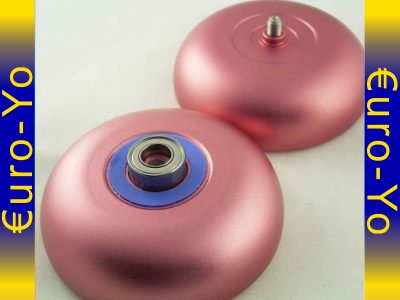
The photo shows the recess in an Any-yo Free Rider yoyo. Both halves of the yoyo are recessed, with one side (lower) fitted with a pad, the other (upper) being left empty (with the option for the owner to fit another pad if desired)
A recessed response system ('recessed pads') means that there is a recess or depression in the yoyo where the pads fit. This makes the pads less responsive since they are recessed into the yoyo. Typically the pad is then flush (level) with the surface of the yoyo. Being less proud than a surface-mounted pad, there is less friction between the yoyo and the string making the yoyo less responsive.
Pros: Most advanced player yo-yos are now made with recessed pads. It makes the yoyos considerably less responsive. The player then has even more options to change response by removing one pad, or fitting thicker or more responsive pads.
Cons: None really as long as you can handle an unresponsive yoyo! If not, you can add thicker pads like the thick Dif-pad to make the pad stand proud of the inner surface of the yoyo and so provide more response.
Modifications: Lots: you can try different pads, different thickness of pads, different combinations of pads. You can leave one side without a pad. Some recessed yoyos can have flowable silicone used instead of pads.
Return to top
|
|
What is a siliconed response system?
Some yo-yos use a product called flowable silicone for their response system. Flowable silicone is most commonly used to repair car windscreens. It is a very fluid liquid silicone material that flows into every corner of any shaped hole and forms a smooth surface where in contact with air. Die-cut silicone sheet is widely used in standard response pads, and when dry, flowable silicone forms the same type of material, making it great for a response system. Some new professional yo-yos are being finished with a flowable silicone response rather than pads. Different colour flowable silicones are available. The most common is a clear transparent silicone, there are also red silicones.
Many yo-yos with a recess can be siliconed. This means that a yo-yo that is sold fitted with pads can have the pads removed and have silicone applied in their place. They can be 'siliconed'. If you hear yo-yo players talking about wanting to 'silicon' a yo-yo, they mean using flowable silicone instead of pads.
Many experienced yo-yo players prefer the response characteristics offered by flowable silicone. It is relatively cheap (one tube will silicone a lot of yoyos), has a nice even response, and lasts a long time. It is outside the scope of this little help section to tell you how to silicone a yo-yo: try looking on Google or You Tube for some very good guides. One tip: make sure the recess is thoroughly clean and dry before applying silicone. Don't contaminate the area with lube before or after or adhesion will be compromised. Generally, deeper recesses are better suited to being siliconed. If you are not sure if a yo-yo can be siliconed, you need to do some homework and Google it, or ask around on forums.
I am sometimes asked "should I silicone my yo-yo?". Well, it is up to you, it is a matter of personal preference. Many players prefer it. Will it last longer compared to pads? Maybe! A lot depends on how well it is applied and how suitable the recess of the yo-yo is.
Return to top
|
|
Why won't my yo-yo come back up?
This is a very common question. When you throw a yo-yo down, you expect it to return to your hand. But many modern yo-yos are designed to be unresponsive, that is, not to return to the hand very easily. They are designed to stop at the bottom of the string, and hang there spinning, or 'sleeping'. How you get the yoyo to return to the hand depends on how unresponsive the yoyo is. Some will return to the hand if you give the yoyo a sharp tug upwards. More unresponsive yo-yos will require a little trick called a bind. See 'What is 'binding' and how do you bind a yoyo?' below.
There are things you can do to help make a yo-yo more responsive. I.e. to make it return to the hand more easily. These include:
1. Double or treble looping the yoyo string around the axle. This is very effective.
2. Using a thick lube on the yoyo bearing
3. Narrowing the yo-yo gap
4. Changing the response system
5. Using a new or different type of yo-yo string. A thicker all-cotton string will usually be more responsive.
Remember that yoyos designed for string tricks tend to be unresponsive. Yoyos designed for looping tricks tend to be more responsive. 'Advanced', 'professional' and 'competition' yo-yos will be highly unresponsive and are not suitable for beginners. If you buy an unresponsive yo-yo and it does not return to the hand it is behaving exactly as intended. You can use the techniques described above to increase response but only to a degree.
Return to top
|
|
How can I make my yo-yo sleep longer?
Firstly, let's get something straight: some yo-yos are NOT designed to sleep for a long time. They are designed to be responsive. Typically these are looping yo-yos with wooden, fixed metal or transaxle axles. There is usually little you can do to make these sleep much longer.
Perhaps the most important thing affecting the sleep (spin) time of a yoyo is the players throw. Throwing a yoyo is a skill that takes time to develop. Stronger, faster throws will give better sleep times.
Ball bearing yo-yos generally sleep longer. But this will vary, depending on many things including the response system, ball bearing type, type of string, yo-yo design, the lube used etc.
You can try some things to make your yo-yo sleep longer, but remember this may make the yo-yo less responsive and also that the results will vary.
Things you can try to make your yo-yo sleep longer include:
1. Clean the bearing (see the other FAQ on this).
2. Use a tiny amount of thin lube on the bearing.
3. Widen the gap.
4. Reduce the responsiveness of the yoyo by changing the response system (see FAQ's on response systems for tips).
5. Use a thinner, more slippery yo-yo string. These include 'slicks', 100% polyester, hybrid and alchemy type yo-yo strings.
6. Change the bearing for a higher specification one such as a Ceramic bearing.
7. Keep your yo-yo clean and dry.
8. Play in a vacuum!
Remember that new yo-yos will usually take some time to wear in. The bearings and response systems will need to be worn in by throwing the yoyo. New bearings are often shipped with thick lube in them, and this thick grease will slow the bearing. A clean of the bearing and a drop of thin lube is very effective.
Don't get obsessed with sleep times!
The biggest change you can make to improve your yo-yo sleep times is to IMPROVE YOUR THROW!
Return to top
|
|
What is 'binding'?
Binding a yoyo is a technique used to make a non-responsive yoyo return to the hand. A 'bind' deliberately introduces more string into the yoyo around the bearing to increase friction between the layers of string and the yoyo and so make the yoyo return.
Modern non-responsive 'new school' yoyo's, particularly metal yoyos, are made to be very unresponsive so that they will sleep (spin) for long periods and are designed NOT to return to the hand without using a bind.
Binding is a trick in itself that has to be learned, and it is required to play most advanced yoyos. It is not a trick that a beginner can easily learn. I recommend that binding be attempted once you are reasonably competent with a yoyo. I do not recommend an advanced metal yoyo to anyone until you can bind (which is bit of a catch 22 since you cannot learn to bind without using an advanced unresponsive yoyo!)
There are loads of different binding techniques and it is beyond the scope of this FAQ to describe how to bind here. There are good links on the Links page from this site to some great online video trick archives which demonstrate binding very well indeed - I highly recommend the dif-spinners.com web site by the late, great Ryan Monson, aka Harry Houdini.
Return to top
|
|
Why does my yo-yo hang to one side when I throw it?
This is a very common complaint and 99 per cent of the time the problem lies not with the yo-yo, but with the player. When you throw a yoyo (throw means throw it into a sleeper), unless the yoyo is thrown perfectly then the yoyo will lean to one side as it spins. The gyroscopic force of the spinning yoyo will maintain this position. Even seasoned yoyo players can think their new top-end high performance titanium zirconium precision machined yo-yo is imbalanced due to bad throws.
To help check if the yo-yo is imbalanced rather than just badly thrown:
1. Get another player to throw it for you and see if they have the same result.
2. Note if the yoyo always leans to the SAME side. If it does, this is more suspect.
3. Check the pads are well fitted.
4. See if you can improve your throw! Stick with it for a few days.
5. Throw a hard sleeper: lightly touch the rim of the yoyo: if any wobble disappears and stays that way after removing your finger then the yoyo is ok. This is a hard test to perform if you are not actually able to throw a hard sleeper!
Return to top
|
|
Has my yo-yo got vibe or wobble?
When you throw a yo-yo it often appears to vibrate or wobble. Usually this is due to the throw. One way to see if the vibe is due to an imperfect yo-yo, is to throw a hard sleeper, hold the yo-yo up so you can see it and lightly touch one rim with a finger. The wobble should disappear. If the wobble returns when you remove your finger, then you might have an unbalanced yo-yo. If the wobble does not return, then your yo-yo is ok: your throw is the cause of the wobble.
Remember that a wobble can also be caused by other factors such as a badly fitted response pad, an out-of centre axle, poorly assembled yoyo, dents and dings etc. Wobble can easily be introduced to a yo-yo through accidents, such as hitting a hard surface or being trodden or sat on. Pro metal yo-yos are precision machined to very fine tolerances, and it only takes a small accident to spoil the weight distribution and introduce vibe.
Note that every yo-yo has some degree of vibe or wobble. Generally, more expensive metal yo-yos should have less vibe. Some players prefer a little vibe to give feedback during play (or so I have been told!).
Return to top
|
|
Why does my Auto-return yo-yo not return anymore?
Auto-return yo-yo's need to have their string double or triple looped around the axle to make the yoyo return. When you change the string you must make sure you double or triple loop the string over the axle (there is a separate FAQ about how to do this). This ensures there is enough friction between the yoyo axle and the string for the yoyo to climb back up the string when the auto-return takes effect. If there is only a single loop the string slips around the axle and the yoyo will not return, or will do so but only slowly.
Rarely, the yo-yo return mechanism can fail. This is almost always due to the yo-yo hitting the ground or a hard object, breaking the auto-return mechanism. There is not usually a fix for this.
Return to top
|
|
Do I need a yo-yo glove?
You can play without wearing a yoyo glove, but as you progress into more advanced tricks you may want one to reduce the pain of yoyo string burn on your catching hand and help the string to slip more freely and quickly over your fingers. Yo-yo gloves are usually sold singly, not as pairs. Yo-yo gloves can be worn on either hand. You normally wear just one glove, where it is worn on the catching hand to reduce string burn when performing string tricks. However, some players also like to wear a yoyo glove on the throwing hand. The gloves are generally made of a thin 'slippery' material such as nylon which allows the yoyo string to glide over the glove with low friction. A yoyo glove wants to have quite a snug fit so that is feels like a second skin for fast play and good control.
Return to top
|
|
How do I learn to yo-yo?
You do not have to buy a book or DVD to learn how to yo-yo. The internet is a fantastic free resource for learning how to yo-yo. There are some really great free web sites out there that will show you everything from the basics of yo-yoing to advanced yoyo tricks. It is usually easier to learn a trick by watching a video than by looking at a picture or reading a text description. A film of a trick being performed is easier to follow than a 2D picture. The web is a very dynamic ever-changing place so it is difficult to recommend one web site, but those web sites I have been particularly impressed with are linked to from the Euro-yo Yoyo Links page. The web is also the best place to see the very latest tricks performed by the World's best yo-yo players and is the most up-to-date resource for all yo-yo players.
The big yo-yo companies (notably Duncan and Yomega) have produced some excellent yo-yo tuition DVDs. These are professionally produced and have the added benefit of being in a larger format than most online web sites so are easier to see. You can also freeze the action and in some cases view the tricks from different angles. The downside is that they are not free but they are highly recommended. More specialist yo-yo DVD's have been produced by smaller outfits or by yo-yo enthusiasts. Some of these are entertaining rather than educational and might do more to show you the latest tricks without actually telling you how they are done. Most of the enthusiast DVD's are not really aimed at beginners, though they are amazing to watch.
Finally, books. These are cheap, generally well written and nicely illustrated. The ones intended to teach you to yoyo will usually cover everything you need to know to get started and to perform yoyo tricks. Often they will cover basics like how to wind on a yoyo string (something which might be neglected on online web sites or in a DVD). They are 100% portable(!) and can be read on the move. Be warned though that even the best book will have trouble conveying in words and pictures the more complex moves required to pull off advanced yo-yo tricks.
Return to top
|
|
What is the best yo-yo?
There isn't a 'best' yo-yo. Rather like there is not a 'best' cheese! Too much is down to personal preference. The yoyo shape, weight, material, bearing, axle, response system, appearance, price and much much more all contribute to what makes a yoyo good and are all subject to an individuals personal preferences.
However, some yo-yos are definitely bettter than others. More expensive yo-yos ought to be better constructed, made of better materials, have a superior design, be machined to finer tolerances, have unique features etc. But as with many things in life, price does not always a sign of quality. For example, some yoyos will be more expensive because they are a limited edition, highly sought after or collectible.
Another complication is that yo-yos are designed with different tricks in mind. A 'best' quality looping yoyo will be pretty average at best when it comes to performing string tricks, because the shape is all wrong.
The best way to determine which yoyo is 'best' for you is to try it or at least read reviews and to seek the opinions of others. Remember that if you get the yo-yo bug you will probably end up with a collection of yoyos, with several different yoyos that are 'best' for particular tricks!
Return to top
|
|
What yo-yo sleeps the longest?
The time a yo-yo will sleep for (spin for) depends on many factors that affect the friction between the yoyo and the yoyo string and air. Friction slows the yo-yo. A major factor is the axle type.
A yo-yo with a wooden axle will not sleep for long, if at all. There is a lot of friction between the axle and the string. This is a good thing for looping tricks, and wooden axled yo-yos remain very popular.
Metal axles are smoother than wood and reduce the friction a little.
Transaxle yo-yos have a sleeve over a usually metal axle that spins more freely. They will sleep for some time but not usually for very long.
Ball bearing yo-yos provide the least friction and so have the potential to spin longest. BUT there is a big difference in spin times between ball bearing yo-yos. This is because so many other factors come into play, including the width of the gap, quality and type of bearing, how the bearing is lubed, the response system, the string type, the diameter of the yoyo, the distribution of weight on the yoyo, the finish of the yo-yo, the aerodynamics of the yoyo etc.
I am often sent a list of yo-yos and asked "Which of these yo-yos will sleep the longest" and usually I do not know. I have not measured them! Some people really get into long spin times but to me this is not as important as how a yo-yo plays. If you want a yo-yo that sleeps for a long time, get reasonable yo-yo with a ball bearing axle system, clean the bearing, add a drop of thin lube, use a polyester string, reduce the responsiveness if you need to, and enjoy.
Return to top
|
|
| |

Questions to be answered!
I will answer these questions when I get time....
When will X yoyo be available again?
How to silicone a yoyo recess
How to make a yo-yo more responsive
How to make a yo-yo less responsive
Adjusting the yo-yo gap
Yoyo Wobble and Vibration
What are the different yo-yo string types?
How long are yo-yo strings?
There is no standard length. Yoyo string lengths vary with manufacturer and even with the batch produced.
What do I need to buy?
How to tie the yo-yo string.
Why did my yo-yo axle break?
How to look after your yo-yo.
My yo-yo doesn't return to my hand. Why?
How can I make my yo-yo sleep (spin) for longer?
My yoyo is noisy, should I care?
What are the different types of yo-yo bearings?
What is 'double looping' a yoyo?
What are looping tricks?
What are string tricks?
What is the difference between a looping yoyo and a string trick yoyo? |
|





















